Gemini Rue: Collector’s Edition Review
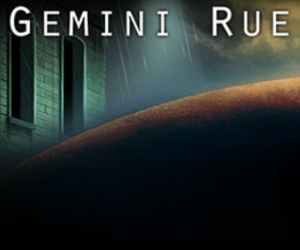 Game: Gemini Rue: Collector’s Edition
Game: Gemini Rue: Collector’s Edition
Developer: Joshua Nuernberger
Publisher: Wadjet Eye Games
Available on: Windows PC Only
Since 1997, budding Adventure Game Developers have been using AGS, a freeware development tool known as the Adventure Game Studio, to produce their own point and click games, attempting to emulate the 2D classics of old from the big names such as Lucasarts and Sierra. Many of these games are simply fan projects, gamers who want to create spin-offs from their favourite franchise, re-using sprites from existing games. However, there is also a solid community of developers who work on their games for years, and create fully-featured titles that are entirely their own work. One of these is Joshua Nuernberger, whose third Adventure Game made with AGS has come as somewhat of a revelation, and is now receiving a special Collector’s Edition boxed retail release, courtesy of Indie Game publishers Wadjet Eye Games.
STORY: Set in the year 2228, in a dystopian future where we find ourselves in the Gemini System, a system of planets controlled by the Crime Syndicate the Boryokudan. Throughout the game, players will get to control two protagonists; Azriel Odin, a former assassin for the Boryokudan who is now a crime fighter searching for his missing brother, and Delta Six, a man known simply as Charlie who finds himself in some sort of rehabilitation centre named Center 7, where he has just had his memory forcibly erased.
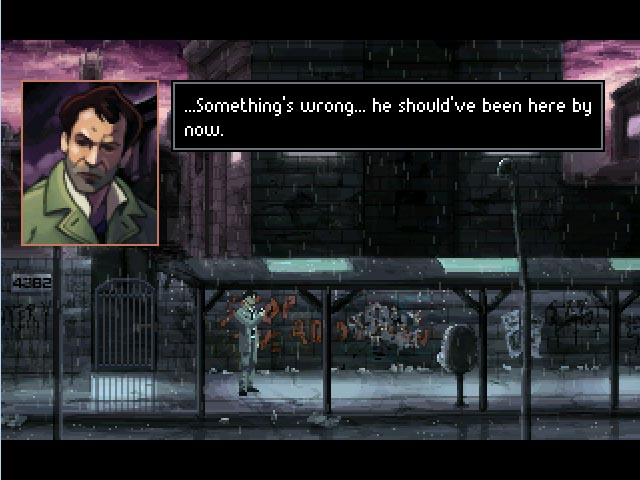
Kicking off things on Barracus, a rain-soaked planet that is full of abandoned buildings and junkies, we see that the title is obviously greatly influenced by science fiction titles such as Blade Runner. In terms of tone as well as setting, the title obviously pays homage to the cult classic, but it also creates its own identity. In a world where the citizens are afraid to stand up to the organised crime syndicate, their only other option is to turn to “Juice”, a new drug that the Boryokudan are pushing across the Gemini System. Following the Gemini War (previous to the events in the game, but referenced regularly), the government has lost control and the crime families have seized the streets, and there is something very suspicious going on, with citizens disappearing mysteriously. As both Azriel and Delta Six, players will help unearth the truth behind the strange goings-on at Center 7, and to put a stop to them.
The story is very well written, and there is a palpable feeling of tension and unease throughout the game. Characters do come across as believable and desperate to get out of the situation they find themselves in, adding further to the drama of the title. The pacing is also very well-handled, with action switching between the two main characters, the tempo is kept high and you always feel that there is the need to be getting on with the task at hand and working towards your goal. There is a good deal of mystery in the title, yet the developer does a good job of drip-feeding players more information as they go along; just enough to keep them excited to carry on and find out more.
GRAPHICS: The game has intentionally been created in a very old-school style. Using a limited palette size and pixel art, the developer has created a game that instantly looks retro and captures the spirit of a future world gone bad. The hand painted backgrounds are dramatic and full of detail, but still mesh well with the pixellated character models. That said, the character models certainly aren’t poor, the animation cycles and actions are all nicely-rendered, and a surprising level of realism is squeezed out of just a few pixels. Perhaps to help flesh out the characters a little more, when players enter conversation with another character, portrait boxes will appear on-screen, showing a far more detailed rendering of those involved. These are semi-realistic, stylised images, that do let the player get a better idea of what the character is like; so it is a helpful little touch.

SOUND: When the title was first put together, the sound design was intended to be much simpler. With the development that the game would see, and a wider release through the partnership with Wadjet Eye Games, the budget and scope for more complex original music and voice acting was added, so the sound design took a turn for the more professional. And, in general, the voice acting is of a good standard; especially for an independent title. All of the voices fit in well with their characters, for instance you can tell when a character is a bit sneaky or sly, by the intonation in his voice, and the protagonists both have voices that fit well with their character. With voices being the standard nowadays, the game would have seemed a little basic or quiet without them, so it was a good move to add them in.
The background music is also very effective. It may not play all the time during gameplay, but this means that the audio can be used to accentuate or emphasise a particularly dramatic or emotional part of the game. In terms of style, the composer takes influence from many different places, with elements of electronica and futuristic sounds, set against more orchestral music. Some of the music is quite close to the work of Thomas Newman (famous for his soundtracks for American Beauty and Road to Perdition). This helps create a somewhat dour and downbeat mood that perfectly fit the settings we find ourselves in throughout the game. The composer also makes use of music that seems influenced by the soundtrack to Blade Runner, with one track in particular obviously paying homage to that film. The music is of a very high standard, as are the sound effects, and you would be forgiven for forgetting the game was still only an independent venture.
GAMEPLAY: At its core, the gameplay is very much the traditional point and click style, but there has been several new features added in which lend a more action-orientated lean to proceedings. The bulk of the title is made up of very traditional point and click interactions, with inventory puzzles and conversation trees being central. So this should be familiar territory for anyone who has ever played an Adventure Game such as Broken Sword or Monkey Island.
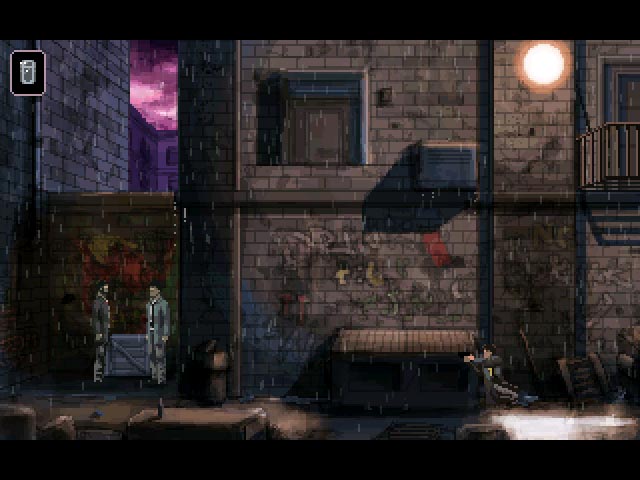
The game differs from the norm in several respects, firstly, in a not-so-revolutionary way. At certain points in the game you can choose to switch between the two protagonists as you wish. Their puzzles do not rely on one another, so you can move from one to the other when you like. Get stuck on a puzzle with Delta Six, you can simply switch to Azriel and work on his dilemma for a while, in which time you might figure out the solution for the previous puzzle. This does help to give the impression of freedom and a little non-linearity in the game, but really this is only aesthetic; both puzzle sets must be completed before you can progress. It is this sort of option that makes the player feel more empowered, and that their story may be different from another user playing the same game.
More dramatically different, there are the crate moving and shooting features. Whilst crate puzzles have often been a feature in Adventure Games, Gemini Rue uses the WASD buttons on the keyboard to control your character for sliding around and climbing onto boxes, which is required to reach certain areas or reveal items. This is all pretty logical and straight-forward stuff, just a new control method for it rather than simply pointing and clicking.
The shooting sections are quite a departure for the genre however. Players must get into cover, and then, making use of the WASD keys again, they can duck left or right out of cover, reload and shoot. These sections are all obviously signposted, so there are few situations where you will die without having time to react, but the controls do take a little getting used to. There is even an extra button for holding your breath, which allows the player to pull of a headshot that will cause much more damage to their enemies. These controls are quite easy to pick up, but this is mainly down to the fact that the game provides a tutorial sequence at the rehabilitation centre, where you are taught all of the basics and given the chance to practice. This does really help you to get the hang of it all, but if you still struggle after all of this, there is the option to toggle between easy, medium or difficult gun sequences; so you can pick your own challenge levels. This means that if you enjoy puzzles but hate action, you can choose easy and barely be tested by the gunfights.
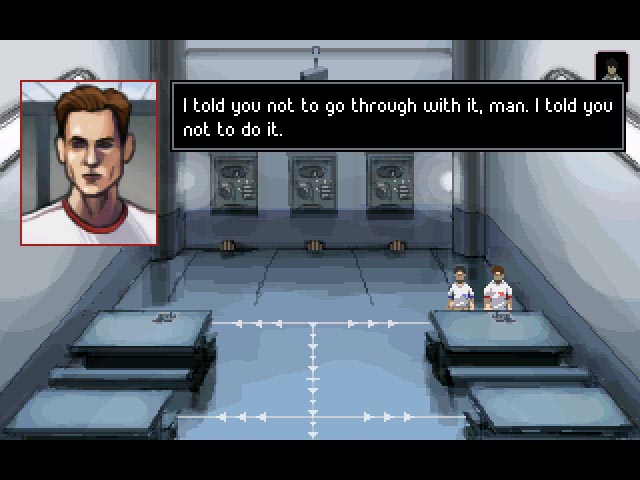
The only other major feature is your electronic notepad. This will automatically record all evidence and clues that you collect throughout the game, as well as recording important names and phone numbers that can then be recalled in conversations. This allows you to question people about particular people or clues whenever you enter a conversation, make phone calls to contact new leads, or even to speak to your partner for a quick hint or some help. The game is good at providing small hints and nudges, without ever being completely in your face with a hint system. This is good because it means the game doesn’t become too easy, but at the same time if you do become stuck you will usually be able to find some information or get some advice that will lead you towards the answer. The level of challenge is good, without becoming too frustrating; which has traditionally been one of the downfalls of the genre.
LONGEVITY: The game may not be expansive, but for those who wish to delve further into the title there is a lot of additional information and back story to be found as you go along, which helps to flesh out the story. Whilst the outcome and the objectives in the game are all pretty linear, there is some variety in the path you take, in that there are several possible solutions for many of the puzzles in-game. After finally completing the title, which is a good length for an Adventure Game, featuring around 60 locales, you might want to delve back in for another try, simply so you can try some different solutions to the puzzles. This is still a fairly limited title though, and it does suffer the same fate as most Adventure Games in that the replay value is pretty low.
The Collector’s Edition extras are mainly for show, such as a downloadable soundtrack and an in-depth developers commentary. But also included are two previous Adventure Games developed by Joshua Nuernberger. neither of these have anything like the polish and detail of Gemini Rue, and are both fairly short, but they do show the inventive game design that the developer has become famous for, and are good example of how the Adventure Game genre can evolve to provide new experiences that aren’t simply re-treading old games.
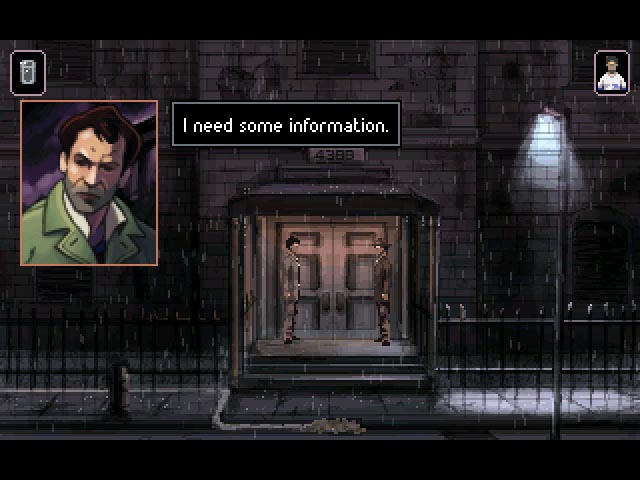
VERDICT: It is a real testament to the one-man development team (who admittedly did get some help with music and sound effects) that the game has built up such a following that it has warranted a disc-based retail release. Playing through the title you can really see the care and attention that has gone into shaping one mans vision through to a conclusion. The game is a real love letter to the classic graphic Adventure titles that ruled the marketplace in the early nineties, but with some of the spit and polish that you would expect of a more modern game.
The story is the heart of the game, and it really keeps ticking along at a great pace, intriguing the player, pulling you forward to solve the mystery and to save the characters. The setting and ideas behind the title might not be the most original ones in the world, and its filmic influences and references are worn clearly on its sleeve, but it never relies on homage as a crutch, the game carves its own identity and will keep you fascinated. The Adventure Game remains somewhat of a niche market, and whilst touch-based control on devices such as the iPad or Nintendo DS have opened up the genre to a wider audience, Gemini Rue remains very much of the old-school. It does try some new features that aren’t commonplace in the genre, such as the shooting mechanic, but it maintains its retro charm. This may put off some players, those who grew up on 3D gaming, and the Adventure Game genre as a whole is a somewhat acquired taste, but if people can look past the aesthetics, this is an involving and exciting title.






